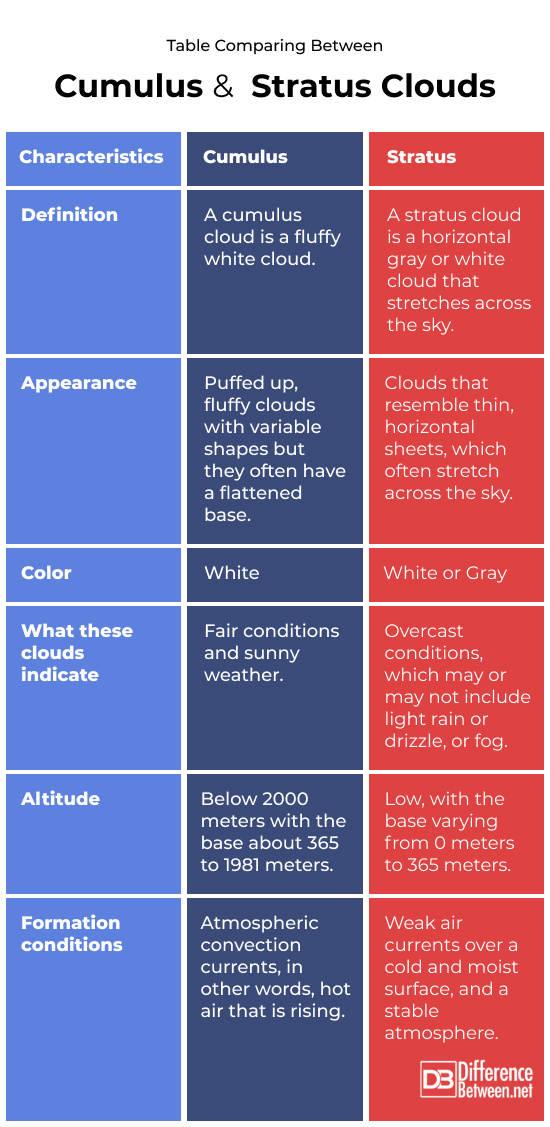Difference Between Cumulus and Stratus Clouds
Everybody knows about clouds right? You probably see them every day. Clouds are like puffs of water or ice in the sky. They form when warm air goes up and cool down, turning into tiny drops or crystals. You must have noticed they change shape constantly; at least some of them do, while others stay the same all day along. Some are just water droplets, while others are made of ice crystals. Now, clouds can be classified into two main types based on their stretch and altitude: cumulus and stratus. Each type of cloud reflects different weather conditions and atmospheric dynamics. In this article, we break down the difference between cumulus and stratus clouds.

Cumulus Clouds
Cumulus clouds look like puffy cotton balls floating in a blue sky. They have a flat base and clear edges. They show up when the sun is shining and usually form at levels not too high and not too low. Typically, cumulus clouds float as low as 1,005 m above the ground. Sometimes, they grow taller and turn into big storm clouds called Cumulonimbus. Each cumulus cloud is composed of one or more thermals. Cumulus clouds over the sea are common in autumn and winter when the sea is warmer than the land.

Stratus Clouds
Stratus clouds are stratified or layered clouds that make gray, flat sheets covering the whole sky. These clouds might bring mist or drizzle but don’t usually bring rain. They are usually found low down, close to the ground, typically below 1,981 m. When these clouds show up, the sky becomes dull and gray. They often bring light rain or tiny drops.
Difference between Cumulus and Stratus Cloud
Shape and Appearance
– Cumulus clouds look like puffy little cotton balls that grow into cauliflowers during the daytime. They are fluffy and exist in patches, floating throughout the sky. They have clear edges and usually show up when the sun is shining. Stratus clouds, on the other hand, look like thin, white sheets covering major portions of the sky. Unlike cumulus clouds, these are flat and spread out without sharp edges.
Altitude
– Cumulus clouds are typically classified as low clouds and are composed of more than one thermal. They form at low to middle altitudes, usually 3,300 feet (1,005 m) above the ground. Stratus clouds, on the other hand, sit very low to the ground and usually form below 6,500 feet (1,981 m).
Weather Conditions
– Cumulus clouds usually represent fair weather conditions. However, they can grow larger on hot, humid days. They keep rising higher and higher and then can develop into storm clouds. Stratus clouds, on the other hand, often bring overcast skies and can indicate the possibility of light rain or drizzle, but they don’t bring rain all the time. Fog is a stratus cloud at ground level.
Growth and Transformation
– Cumulus clouds can grow vertically and develop into larger clouds like Cumulonimbus, which can bring thunderstorms. This growth happens as warm thermals rise through cooler air on a sunny day. Stratus clouds, however, have a uniform appearance and are characterized by horizontal layering. They usually maintain a relatively flat appearance and do not have significant vertical growth.
Cumulus vs. Stratus Clouds: Comparison Chart

Summary
To sum it all up, Cumulus clouds resemble fluffy cotton balls, appear at moderate heights, and indicate fair or changing conditions. Stratus clouds, however, stretch like a gray blanket closer to the ground, signaling overcast skies and the possibility of light rain. Fog is a stratus cloud at ground level. Cumulus clouds climb upward as they form. Understanding their distinct shapes and locations will allow you to better predict the weather and prepare for the day ahead.
FAQs
What are the 3 differences between cumulus and stratus clouds?
- Cumulus clouds look like puffy little cotton balls, while stratus clouds look like gray, flat sheets.
- Cumulus clouds exist in patches and have clear edges, while stratus clouds are flat and spread out without sharp edges.
- Cumulus clouds can grow vertically, while stratus clouds grow horizontally.
What is the difference between cumulus, stratus, and cirrus clouds?
- Cumulus clouds are fluffy and fair, stratus clouds are flat and gray, and cirrus clouds are thin and wispy.
- Cumulus clouds may grow into storms, stratus clouds suggest drizzle, and cirrus clouds often appear before a weather change.
What is the difference between stratus, cumulus, and cumulonimbus clouds?
Stratus clouds are flat and gray, cumulus clouds are fluffy and may signal fair weather conditions, and cumulonimbus clouds are towering and bring storms.
What is the difference between strato and Alto cumulus clouds?
Strato-cumulus clouds are low, gray, and sometimes bring light rain. Alto-cumulus clouds are middle-level, white, and might show changes in the weather but usually not heavy rain.
What type of cloud brings rain?
Cumulonimbus clouds can bring rain due to their height and vertical growth.
How do you identify a cumulus cloud?
Cumulus clouds appear fluffy with distinct edges and often resemble puffy cotton balls. They grow taller as they develop. You can easily spot them on a sunny day.
- Difference Between Caucus and Primary - June 18, 2024
- Difference Between PPO and POS - May 30, 2024
- Difference Between RFID and NFC - May 28, 2024
Search DifferenceBetween.net :
Leave a Response
References :
[0]Scorer, Richard and Harry Wexler. A Colour Guide to Clouds. Amsterdam, Netherlands: Elsevier, 2013. Print
[1]Perkins, Oliver. Reading the Clouds: How You Can Forecast the Weather. London, UK: Bloomsbury Publishing, 2018. Print
[2]Fleisher, Paul. Vapor, Rain, and Snow: The Science of Clouds and Precipitation. Minneapolis, US: Lerner Publications, 2010. Print
[3]Image credit: https://www.canva.com/photos/MAAUWFr5tqU-cumulus-clouds-/
[4]Image credit: https://www.canva.com/photos/MADAoFsIOMA-stratus-cloud-sky/
